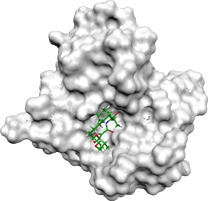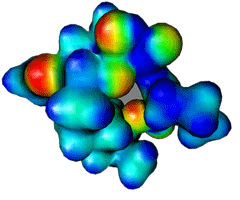
 |
The essential elements of life--self-replication, information processing, and metabolism--occur largely by specific interaction between biological molecules. Understanding how two molecules recognize each other is thus one of the fundamental issues in biochemistry. Molecular recognition is also a central topic in applied biochemistry because it determines whether a compound possesses useful clinical properties.
 The idea that molecular recognition lies in the complementarity of interacting surfaces was first clearly formulated by a Dutch chemist Emil Fisher, who proposed in 1894 that the enzyme and substrate fit together "like lock and key". A modern view on molecular recognition, called induced fit, takes into account that the interacting molecules are flexible and can change their shape during the recognition process. The induced fit has been observed experimentally for many protein-ligand interactions. At the molecular level, the following factors contribute to the complementarity between two molecules:
The idea that molecular recognition lies in the complementarity of interacting surfaces was first clearly formulated by a Dutch chemist Emil Fisher, who proposed in 1894 that the enzyme and substrate fit together "like lock and key". A modern view on molecular recognition, called induced fit, takes into account that the interacting molecules are flexible and can change their shape during the recognition process. The induced fit has been observed experimentally for many protein-ligand interactions. At the molecular level, the following factors contribute to the complementarity between two molecules:
The strength of binding of a ligand to a macromolecules is governed by the free energy change in the binding process. The binding free energies can be determined experimentally but this requires availability of both the ligand and the macromolecule. An alternative means of obtaining binding free energies is a computer simulation. Typically, only free energy differences between two similar ligands can be reliably calculated. The prerequisites for accurate results are the availability of a reliable force field and extensive sampling of the phase space during the simulation. Currently, force fields such as CHARMM, AMBER, OPLS-AA, and MMFF are widely used for biomolecular simulations.
Development of more accurate force fields is going on in many research laboratories. In general, the reliability of force fields can be improved by two approaches:
Inclusion of terms such as polarization or charge transfer into the force field model increases the computational cost of the simulation substantially. This approach, however, may be necessary for description of many biological processes. On the other hand, promising results for ligand-macromolecule interactions have been achieved with nonpolarizable force fields such as OPLS-AA or AMBER. This success, coupled with high computational efficiency of these 'simple' force fields, suggest that traditional nonpolarizable force fields can be valuable in evaluating ligand binding affinities in many systems.
Our contribution in this area includes an alternative parameter set for the OPLS-AA force field. This parameter set is expected to be suitable for simulation of many pharmacologically important compounds including macrocyclic polyketides. A new set of bonded and nonbonded parameters was developed for alkanes, alcohols, ethers, hemiacetals, and esters based on the following principles:
The parameter set, which is compatible with Dr. Jorgensen's program BOSS, is available upon request. The parameterization is described in a J. Comp. Chem. article 'Parameterization of OPLS-AA force field for the conformational analysis of macrocyclic polyketides'.
 Some macrocyclic polyketides, such as FK506 (sold as immunosuppressive drug Tacrolimus) show potential neuroprotective and neuroregenerative activity. For example, research from the laboratory of Bruce Gold has shown that administration FK506 dose-dependently accelerates recovery of peripheral nerve function in injured rats. Recent progress in cloning and modifying genes that encode synthesis of such macrocyclic polyketides by Kosan Biosciences has given hope that controlled biological synthesis of neuroregenerative polyketides is feasible. The J. Comp. Chem. article outlines computational strategy for identifying polyketides that would have high neuroregenerative activity without suppressing the immune system. This research project was generously supported by Christopher Reeve Paralysis Foundation.
Some macrocyclic polyketides, such as FK506 (sold as immunosuppressive drug Tacrolimus) show potential neuroprotective and neuroregenerative activity. For example, research from the laboratory of Bruce Gold has shown that administration FK506 dose-dependently accelerates recovery of peripheral nerve function in injured rats. Recent progress in cloning and modifying genes that encode synthesis of such macrocyclic polyketides by Kosan Biosciences has given hope that controlled biological synthesis of neuroregenerative polyketides is feasible. The J. Comp. Chem. article outlines computational strategy for identifying polyketides that would have high neuroregenerative activity without suppressing the immune system. This research project was generously supported by Christopher Reeve Paralysis Foundation.